Archive for ‘General’ Category
Organize Away Frustration: Practice The Only Good Kind of “Intolerance”

tol · er · ate –– /ˈtäləˌrāt/; verb
- allow the existence, occurrence, or practice of (something that one does not necessarily like or agree with) without interference.
- accept or endure (someone or something unpleasant or disliked) with forbearance.
What Are You Tolerating?
Years ago, before I became a professional organizer, I was in the habit of reading books about life coaching. They all noted that the first step to creating the kind of life you want was to start by identifying the unsatisfying things that you tolerate. Knowing what makes you unhappy helps you create a strategy for eliminating those “tolerations,” the obstacles to your happiness.
Professionally, I get to use my role as an outside observer to help spot, and eliminate, what clients are tolerating. Too often, people can’t see the forest for the trees. They know they’re frustrated, but they often can’t pinpoint the origin of the pain.
I often assign homework to new clients, asking them to keep a small notebook or pad and write down every instance of when and where they’ve been annoyed by something in their spaces or schedules.
It’s easier to create an effective filing system if you eliminate the papers and documents that are out-of-date or unnecessary, and you’re not going to want to do it if your hanging file rail jiggles or squeaks every time you open a drawer. You can’t organize your closet if it’s full of clothes that don’t fit or flatter your body (or is piled with things that don’t belong in your clothes closet in the first place!), and you won’t work on it at all if the closet’s overhead lightbulb is burned out.
Once you identify a problem, you can begin to fix it.
Forgotten and Hidden Obstacles
Stated that way, it’s obvious. You can’t solve a problem that you don’t know exists.
But even knowing you have a problem doesn’t mean you’ll be inclined to fix it right away. We humans are procrastinators! If a light bulb burns out, but you don’t replace it immediately, the first few times you flip on the switch, you get frustrated anew – you’re alert to the annoyance and it’s acute.

But after a while, you get accustomed to less illumination over your bathroom mirror or dining table, and this problem becomes a low-level hum of almost-forgotten annoyance. You knew you had a problem, but as you learned to live with it, it became chronic, and consciously, you ignored it. Often, a second, or even a third light has to burn out before you can be bothered to make a change. We “put up” with things, tolerating them because we assume the physical energy to fix it will be greater than the mental energy of putting up with it. It’s not.
Professional organizers are not immune to ongoing tolerations. In the vein of “the shoemaker’s children go barefoot,” I’ve been known to let my small frustrations simmer into a stew of crankiness. But if you’re not in a mindset to actively take note of the problem in order to solve it, you’re likely to suffer in silence (or crankiness) without a sense of urgency or agency.
The Shower Curtain Liner Example
I’m short. I’m not exactly built in miniature, but I’m only 5’3″ and a few microns. A standard shower curtain/liner is typically 72 inches long, and to prevent the shower curtain from touching the floor or curving onto the floor of the tub, curtain rods should usually be installed around 75-to-77 inches from the floor. I have a lovely, gossamer shower curtain that hangs outside the tub, and an ordinary vinyl curtain liner hanging inside.
Cleaning vinyl shower curtain liners is a pain, and they’re cheap, so it’s easier to just replace them after a while.
The problem? With most shower curtain rings, even if you don’t need to launder the curtain, you still need to remove the curtain and the liner from the ring to access the liner. Because the ring itself is hanging from (or wrapped around) the rod, you have to be able to manually twist a plastic or metal portion of the ring to open it, releasing both the curtain and the liner.
Then you have to line up the button-hole style openings of the new liner to the ones in the curtain, and, one-by-one, insert the curtain rings and get the clasp to close. Depending on the kind of curtain hooks, you may have to twist the ring into place or pinch your skin on the metal hooks to get everything attached, like getting a new key onto an old keyring.
And if you’re petite, you have to do all of this while standing – balancing, teetering – on the edge of the bathtub.
First world problem, right? I mean, how many times a year do you replace your shower curtain liner? But every time I thought about doing it, I’d waste the powerful mental energy of my shower time grousing about this when I could have been finding a cure for the common cold or having an imaginary conversation with Alexander Hamilton.
But one day, I decided to do the exercise I recommend to my clients. I went room by room, listing each thing I’d been tolerating, each annoyance that was small on its own, but together conspired to frustrate my organized, joyous life.
At first, I only tackled the teeny tasks. I made decisions on clutter, moving things to the laundry, the dry-cleaning bag, the closet, the trash, and so on. Because I’m already fairly organized, this didn’t take long, and it honestly didn’t put much of a dent in my life. But then I kept coming back to that shower curtain toleration.
Instead of just hunkering down and changing the liner, I wondered, “How could this be less of a problem?” and, as I do with clients, brainstormed a list of possible solutions, no matter how silly.
- I could wish really hard that a genie would appear to do the task for me.
- I could move somewhere with a glass shower door.
- I could hire a cleaning person occasionally, timed to when I’d need the liner changed.
- I could buy a higher step-stool to make the height issue less drastic (if still risky).
- I could research shower curtains to see if there were alternatives to the norm.
Wait, what was that last one?
Who actually brainstorms, 'Is there a different or better way to do this?' People who eliminate their frustrations, that's who! Click To Tweet
Finding a Solution
I’m sometimes shocked by how often a client or friend will state a problem and then sigh, as if it’s just something they have to suffer. Occasionally, they’ll say, “Well, I looked at doing X” or “But I tried Y” as if a powerful force field had kept them from going further. But let’s look at some quick, easy options. When facing an problem, you can:
- Google (or use your favorite search engine), tweaking your search terms to find what you need. There are tricks to improve your searches.
- Search on YouTube (which is ideal for solving “how to” problems, whether for plumbing repair, tying a tie, or fixing a stuck spacebar). Last year, someone stole my driver’s side mirror, yanking it from the electrical connections. (Who does that?!) A clear, concise YouTube video allowed me to purchase just the mirror and replace it myself, rather than having to take it to mechanic and pay for service.
- Search in an online forum like (the less dodgy parts of) Reddit, Facebook business or community groups, or neighborhood groups.
- Ask for suggestions on your social media pages.
- Visit or call your local public library. Librarians are experts at finding information. (Let’s say your problem requires a tool, and you don’t want to buy a specialized tool. Did you know many cities have tool libraries?)
- Ask a professional organizer. We know stuff. (We professional organizers get asked all sorts of things. “How do I fold a fitted sheet? What’s the best label-maker? How do I pay off my mortgage faster? Where can I donate this random item that’s of no use to me but might make someone else’s life magical?” Ask your PO!
Back to the Shower Curtain Liner
I didn’t know what I was seeking – yet – but I’d identified the problem. So, I Googled (and Googled and Googled). I found washable shower curtain liners that never need to be thrown away. That was good for the environment, but didn’t help me with my twisty/pinchy fingers or my balancing on the tub’s edge. Then I moved on to looking at all of the different kinds of shower curtain hooks and rings. I’d seen different colors and styles all my life, but they all functioned basically the same – you must twist, snap, or (at best) slide both the curtain and the liner onto/off of one hook.
Eventually, I found the term that would lead me to my solution: double shower curtain rings! The genius of a double shower curtain ring is that it separates the hanging of the shower curtain liner and the shower curtain itself; they hang independently, each on its own hook.
Vaguely reminiscent of tie hangers, the Amazer stainless-steel double shower curtain rings fit the bill!
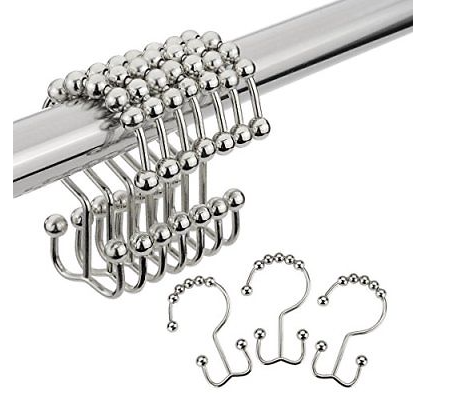
I could now remove the shower curtain liner and replace it without messing with the in-place shower curtain, and it was as simple as sliding the hook through the button-hole. My fingers were saved! Because the there’s nothing to un-hook or un-twist, there’s no need to stand on the edge of the tub – I could easily reach up and hang the new liner in under a minute.
Since finding (and delighting) in this simple solution, I’ve found other kinds of double shower curtain rings.
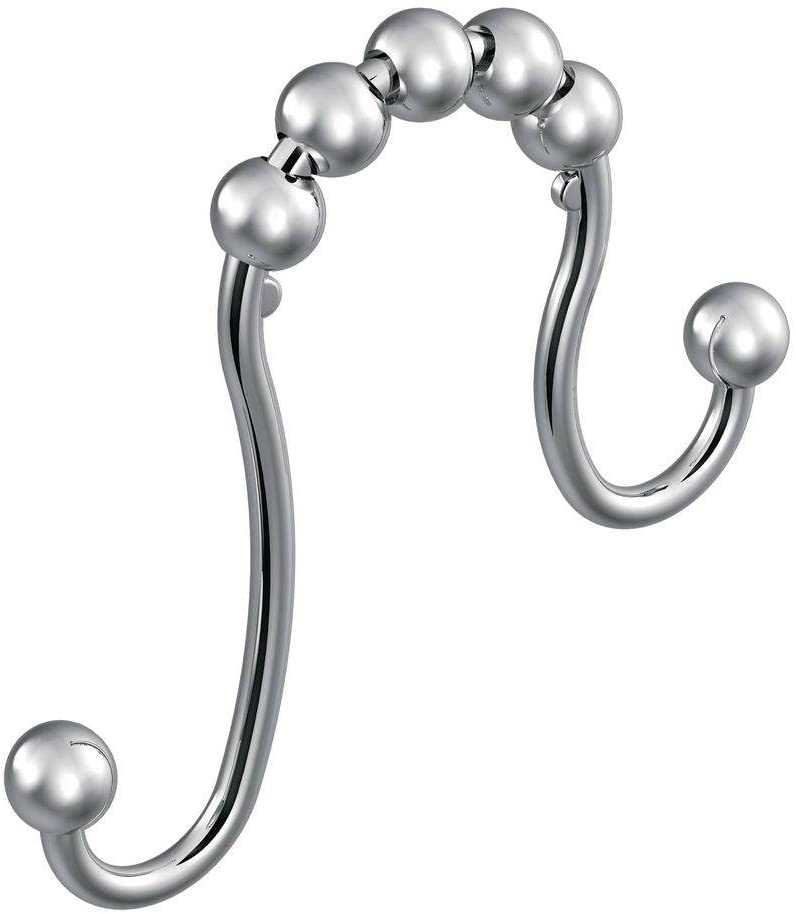
The Moen Double Shower Curtain Rings remind me of Marlo Thomas’ hairstyle on That Girl.

Orb’s Stainless Steel Double-Glide Hooks have an interior (shower-side) hook that hangs lower than the exterior hook. It’s a nifty design, but Paper Doll wonders whether the shower curtain liner may fall too low in the shower, creating a fall hazard.
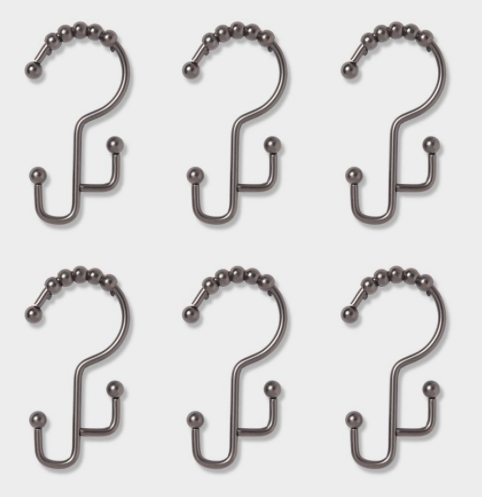
Maybe this is to hide the top of the liner from view outside of the shower, but the Mr. Monk in me would not appreciate the uneven nature.
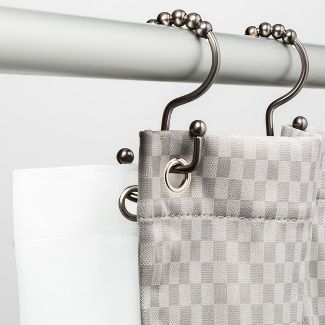
Digging Deeply to Solve Your Problem
Almost all of the things we tolerate can be solved by one of the following:
- A product
- A service
- A change in behavior
- A change in attitude
But first, we have to dig deeply to figure out what the real problem is. Let’s go back to what we discussed at the beginning. (And then read the classic Paper Doll post, 5 “Real Simple” Reasons We Don’t Get the Laundry (or Paperwork) Done.)
Is your family dressing out of the laundry basket? You may complain that nobody helps you put away the laundry, or that you find putting away laundry to be a chore. But perhaps it’s really that your closets and drawers are overstuffed, which makes the prospect of even thinking about putting laundry away too frustrating to consider. So, you tolerate the initial problem (overstuffed closets and drawers), which leads you to tolerate a further annoyance (wearing, washing, and rewearing the same outfits over and over, and dressing out of the laundry basket).
Let’s say you’re not filing your papers. Your instinct may be to dismiss yourself as lazy. But looking deeper, you may realize that a change in attitude or behavior could help, and decide to talk to a therapist or coach. Is it that you don’t have the time or willingness to do your own filing? If so, a professional organizer or assistant may be the way to go.
Perhaps on your own (or with a professional organizer’s guidance), you might realize that it’s not you – maybe it’s not even your system! Perhaps you’re avoiding filing because you’re chronically annoyed by a terrible, squeaky, unbalanced aftermarket file rail?
Over the past 13 years, the Paper Doll blog has covered a wide variety of products that offer solutions to organizing problems, most related to paper and information management. In fact, the most popular post in the history of this blog was the one where I told you about the Smead Heavy-Duty Adjustable Frame.
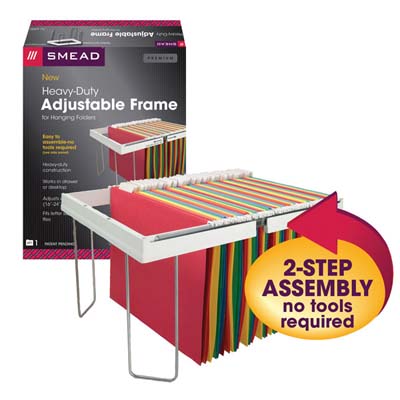
No matter how many times we get annoyed at a problem, we have to call it a problem so that we can start looking for a solution instead of just accepting the annoyance.
Then, if we are confident that a solution can be found, we are much more likely to explore all of the options.
Whether it’s your pantry or your filing cabinet, your to-do list or your darned shower curtain, there are always solutions, and between search engines and experts – like your friendly, neighborhood professional organizer – your life can be better.
Moving forward, I’d like to open up the blog to readers and ask you to submit your organizing problems, Dear Abby-style. (Be assured, your privacy will be protected.) If there’s a product that can solve it, I’ll try to find it for you. If there’s a behavioral approach, we’ll tackle it. And if we need an outside expert, then we’ll talk to a rocket scientist who can find the solution.
What are you tolerating?
Is Your Junk Drawer a Drunk Drawer? 3 Steps to An Organized Junk Drawer
[This post originally appeared on January 8, 2019, and has been updated with additional material as of October 4, 2021.]
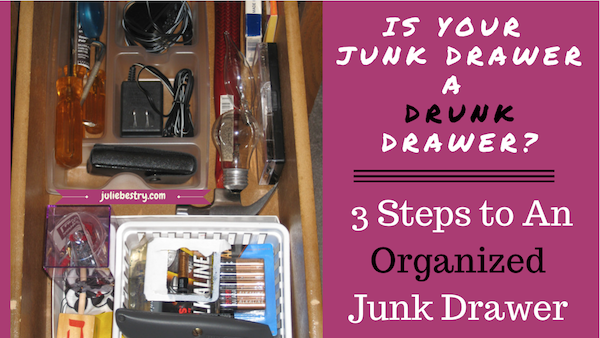
One of my clients refers to her kitchen junk drawer the “Drunk Drawer.”
I don’t drink, so I thought I was missing a pop culture reference. She said that now that we’ve been working together to help her get her life back in order after a few tumultuous years, most of her life is planned out to the nearest detail — organized, categorized, contained. But, on the rare occasion that someone puts a margarita in her hand, especially after a stressful time at work, and she has the opportunity to let her hair down, everything flows freely.
My client notes that with a margarita (or a few) in hand, she says what she wants, she dances to her own drummer, and she gives herself permission to accept that not everything makes sense. Similarly, my client sees that her junk drawer is the one area in her house where she lets the wackiness take over, categories intermingle, and nothing makes sense.
I was reminded of my client’s story when I was approached by Katina Hazimihalis of Dumpsters.com for the Start Fresh: Take the 30-day Decluttering Challenge. (Definitely check it out!) They asked for my advice for Day 7, earmarked as the day of their challenge to “Declutter the Kitchen Junk Drawer.”
 Longtime readers of Paper Doll know that I can never give only a little bit of advice, so there’s a lot that didn’t make it into that post. So, now it’s all here for you!
Longtime readers of Paper Doll know that I can never give only a little bit of advice, so there’s a lot that didn’t make it into that post. So, now it’s all here for you!
WHAT’S THE DEAL WITH THE JUNK DRAWER?
Most of the things in a junk drawer aren’t junk. They just tend to be far from their friends in similar categories — the loose change that never makes it to the wallet, the tools that haven’t found their way back to the toolbox, all those random things we want to keep, but we don’t want to take the time to think about where they belong.
Seth Godin says, “The junk drawer is the enemy of understanding.” I have to agree. If you can’t name it, you can’t fathom it.
With paper, “miscellaneous” is the enemy. Is it financial, legal, medical, household, or personal? Is it action paper or reference paper?
With clothing, it’s either underwear, outerwear, or what you wear! You can subdivide into shirts, pants, dresses, etc., and onward to sleeve length or color or season, but there’s still a basic way to start breaking things down.
Categorically, things need to belong somewhere — is it fish or fowl? Animal, vegetable, or mineral? Ginger or Mary Ann? If you can name it, you can put it into place.
Something has to belong somewhere — is it fish or fowl? Animal, vegetable, or mineral? Ginger or Mary Ann? If you can name it, you can put it into place. Click To TweetBut unlike paper or clothing, not everything has just one home. Some things have a main home and a vacation home — that’s the junk drawer. Yes, you should have a home first aid kit, but it’s helpful to keep a few Band-aids in the kitchen. Yes, most of your office supplies belong in your home office or at your desk, but sometimes you need to grab a highlighter to make sense of the recipe you’re making.
At its best, the household junk drawer can be a miniature subset of categories found around the house. At its worse, however, it’s drunk. It’s sloppy, it makes no sense, and it leads you down a path of regret. Let’s fix that!
WHAT’S THE FIRST STEP TO ORGANIZING A JUNK DRAWER?
Empty that junk drawer. Dump the whole thing out.
It’s rare to hear a professional organizer advise emptying everything out of any space. Usually, we focus on handling one shelf or one category at a time. That’s because the last thing you want to do is get ninety minutes into a closet overhaul and have to pick up your children from school, leaving you with an unusable bedroom and a huge headache.
However, there are two reasons why a complete dump-out makes sense with a drunk junk drawer. First, junk drawers are small. Other than a wallet, purse, or glove compartment, I’d be hard-pressed to find a smaller space that requires concerted attention.
Second, approaching a junk drawer too delicately usually means nothing ever gets completed. People pull out one item at a time and make a few decisions, put a few things back when they decide to keep them, and never quite get around to making decisions about everything. Instead, the best thing to do is to remove everything from the drawer.
Because most junk drawers are in kitchens, what often works is to put a large towel down on the countertop or kitchen table (to prevent scratches). Plop everything down together. Slowly move things to the outer edges of the towel, as if you were searching for a Canadian penny amid all the coins you’ve shaken out of your piggy bank.
Grab the low-hanging fruit first. Remove gum, candy, soy sauce or hot sauce packets, or really anything edible and move to a “snack” box or food storage container on one of the shelves of your kitchen or pantry. Keep sticky, melty, or bug-friendly edibles out of the junk drawer.
Select one item at a time and ask yourself a few questions:
- Is it broken, expired, dried out (like pens or old wipes), or icky? Toss it out!
- Do you ever really use it? If not, you might toss it or donate it.
- Do you find yourself using it often enough that it really needs to be in the kitchen (or whatever room you keep your junk drawer)? If not, move it to a part of the house where it better fits with a category of items already kept elsewhere, like tools or office supplies.
- Do you need this many of whatever it is? Keep your favorite, keep the best, keep the one you’d grab if you needed it. Set the excess free (from the drawer) and either donate or move to a more appropriate place in your home.
Remember, if you don’t use it often, don’t let it take up the valuable prime real estate in your drawer!
NEXT, MAKE SENSE OUT OF THE CATEGORIES
At first glance, it may seem like everything in the junk drawer belongs to the miscellaneous category, but with patience, you’ll start seeing patterns.
Categorize the items into little areas/zones on the counter or table so you get a sense of how many of each thing you have. If you have duplicates, triplicates, or more, you may want to keep one version handy in the drawer, but move the remainder elsewhere, in your own mini-mall of “when I need them” supplies.
Ask yourself, what does the item DO? What is it for? Some category examples:
Batteries — Keep a small supply of the most commonly (and urgently) needed (like AA and AAA). Move the rest, plus whatever other sizes (9 volt, C and D, and smaller batteries for hearing aids, watches, and medical devices) to one divided container (like a tackle box) elsewhere in the house, like in a cabinet or on a shelf in the laundry room, utility room, or basement.
Duplicate keys — Use key cap tags/covers or labels to identify what the keys fit and keep all keys in one container.
5 “Real Simple” Reasons We Don’t Get the Laundry (or Paperwork) Done
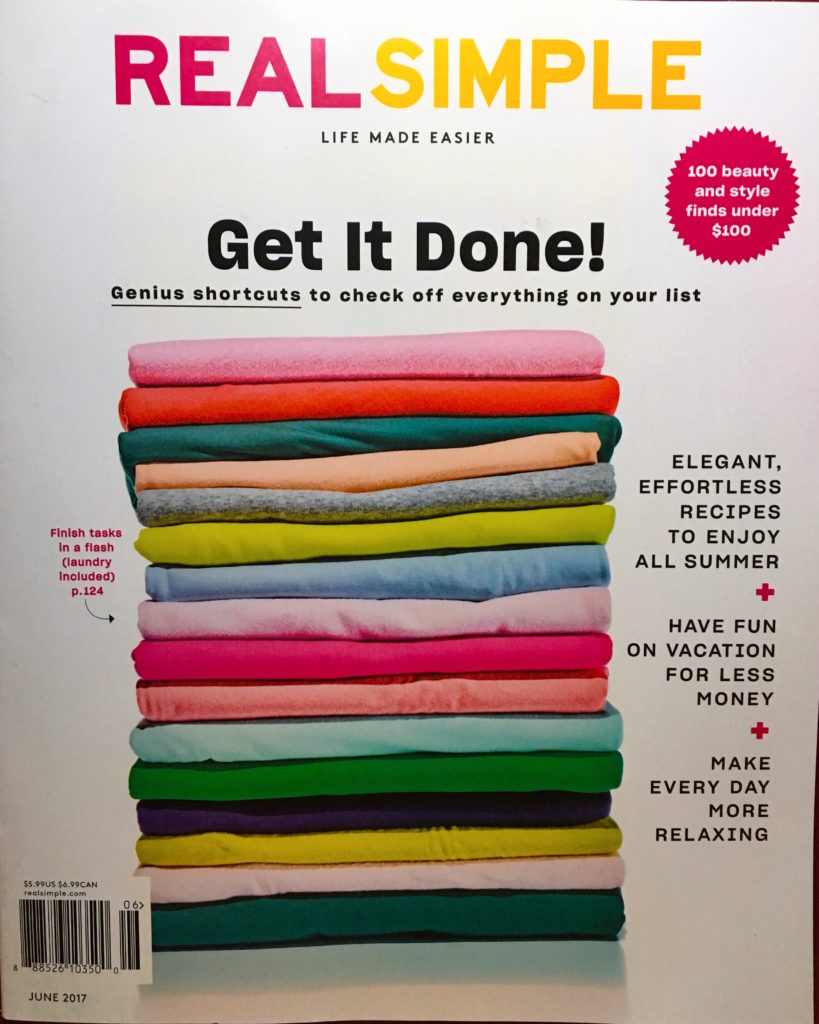
Did you just do a double-take? Laundry? In a Paper Doll post? While we rarely talk about organizing non-paper aspects of domestic life, a recent interview presented an interesting way to use laundry to consider how we procrastinate on other tasks, like paper management.
A writer for Real Simple Magazine contacted my colleague, the fabulous Dr. Melissa Gratias, about the psychology behind why people fail to finish their laundry. Being interviewed by Real Simple is a plumb opportunity, but Melissa – a psychologist by training – focuses on corporate organizing and professional productivity. Melissa honored me by suggesting Real Simple should get my take on the topic.
In the end, in Real Simple‘s June issue about “getting it done,” laundry ended up being just one small section. (See my quotes on page 128!) But you, dear readers, have the opportunity to learn it all!
The reporter asked:
Why [do] we have trouble finishing the laundry (wet clothes left in the machine, clean clothes not folded, folded clothes not put away) – and how we can change our habit to get it done in one swoop so it’s off our plate?
The key word in the inquiry was “finishing” but for many people, even starting laundry is the bigger obstacle. It’s funny to think about why we put off laundry as this huge, scary thing, because our great-grandmothers used finger-peeling washboards and our great-greats had to take the washing down to the river to beat the clothing against the rocks.
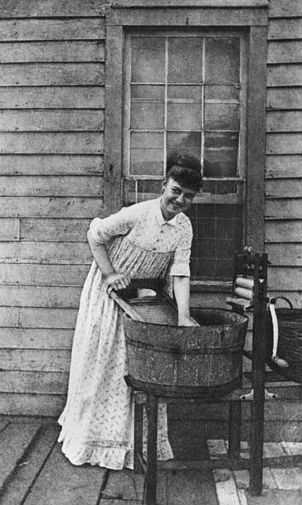
Meanwhile, we drop our laundry in metal boxes and push a few buttons! It’s not particularly onerous, so there must be more to it than the labor — and, as you may have suspected, much of it is psychological. However, small tweaks can dramatically improve our ability to get our laundry done and get us on our way — fully clothed, unstained, and possibly in a fashionable mode of dress.
First, laundry is not a task, but a project. Tasks are singular, but the ongoing saga of the laundry project involves multiple sequential tasks:
- collecting our laundry from the various places we (and our children, and our spouses who sometimes act like children) drop or toss them
- remembering what special tasks (pre-treating stains, removing accessories, securing drawstrings) must be performed
- sorting laundry by color and/or temperature
- washing (but the actual labor is done by the machine)
- transferring the laundry to the dryer, making sure to remove any items that must be line-dried or hung over sweater racks or otherwise given extra attention
- drying (again, done by the machine)
- removing laundry from the dryer in a timely manner so that wrinkles don’t set in
- folding laundry (clothing, bedding, towels, etc.) and hanging clothing
- putting it all away
Wow. These discrete tasks should naturally flow from one to the next, just as the various steps in cooking a meal, but we’re much more inclined to wander away, mid-task, with laundry.
Consider the following obstacles and solutions:
1) PROBLEM: We lack timely triggers to start laundry.
At least, we don’t have them in the same way we do as for preparing a meal. (What? Do you starve for fluff & fold?) Other than in college, when students tend to put off laundry until they run out of clean underwear, most adults don’t have a natural trigger to get started on laundry.
SOLUTION: Create your own triggers.
Pick days and times when you’ll do laundry, like during your children’s piano lessons and scouting meetings on Tuesday and Thursday afternoons, or on weekend evenings after dinner, because the bulk of the work can be done quickly before TV time and the folding can be done during commercials. Set alerts on your phone or computer and let them serve as your valet or butler — albeit one unwilling to do laundry, but happy to remind you that it must be done.
This concept works just as well for paper-oriented tasks. Instead of waiting for your bills to be due (or overdue) — the equivalent of running out of clean laundry — schedule a time to work on your tasks. Bill-paying is a kind of correspondence (though you’re sending money, rather than cheery news), so you might schedule other tasks, like writing thank-you notes at the same time. In your professional life, group tasks like responding to emails or drafting your business newsletter at set times on certain days, like after your staff meeting on Wednesday mornings.
The key is to identify your trigger, set an auditory or visual alert to help you focus on the trigger, and create a time block to complete the task. Maybe the new Time Timer we recently reviewed can help?

2) PROBLEM: We anticipate that laundry will be more of a pain than it actually is.
Although laundry requires multiple steps, most of them are easy and each can be completed in a matter of minutes (except for what the machines do). But many of us recall when laundry was difficult (requiring amassing adequate stashes of quarters, dragging heavy laundry bags from our dorm rooms to basement laundry rooms only to find all the washers were in use), and that sense memory makes us subconsciously rebel against even the idea of doing laundry.
SOLUTION: Find ways to make doing laundry less unpleasant.
- Install better lighting in your laundry room, and clear the space of clutter.
- If your laundry room is also used for other purposes, create a separate laundry zone. Corral your bottles of stain remover, boxes of fabric softener, lint remover, and everything except your heavy detergent bottles, in rubber dishpans or tubs you can easily slide off cabinet shelves.
- Install a valet hook, a rolling clothes rack, and/or a retractable clothes line in your laundry area to make buttoning, zipping, and hanging clothes easy.
- Get rid of (or fix) anything about your laundry area that makes you avoid it.

These tips work for paperwork, too. Do you put off filing, remembering that one time it took you all weekend to deal with six months’ worth of paper backlog? You have almost ten years of Paper Doll advice on how to create a filing system so that everything is logical and easy to find. Join the Clean Desk Club, and learn what papers you need to keep and what you can toss by getting Do I Have To Keep This Piece of Paper? Instead of filing months of papers in drudgery, do short bursts every week, and put on your favorite music to liven the mood.
3) PROBLEM: We lack systems and don’t set aside time to complete the project.
Work isn’t completed until it’s done, and laundry isn’t done until it’s put away. But that injects another problem. Because we procrastinate about doing laundry, we then feel that we have to do ALL THE LAUNDRY all at once, at which we either will fail (making us resentful of that sense of failure) or succeed (making us resentful that we’re expected to ever do it again).
SOLUTION: Create physical and behavioral systems to make the work easy to complete.
- Only start laundry when you’re going to be around to complete a load from start to finish.
- Don’t start a load of laundry late at night – you’ll be tempted to go to bed and leave the items in the washer or dryer.
- Sort laundry sessions by type. Do bedding and towels when it’s more likely you’ll be interrupted. (Nobody minds wrinkled towels).
- Do more smaller loads of clothing. It’ll wash better and dry faster.
- Know how long your washer and dryer cycles take; if they don’t have musical alerts that you can hear from elsewhere in the house, set your kitchen timer or phone alarm to remind you to move the process along.
With papers, conquer your ingrained avoidance by making sure you have systems that make it easy. Create homes for what is to-be-paid and to-be-filed, and a filing system that is aesthetically pleasing (if that’s what gets you going) and ergonomic (with good lighting and a comfortable place to sit so you don’t hurt your back while working).
Behaviorally, you can complete small tasks in whatever time you have available, but if you’re working on a larger project, like developing a family budget, writing your graduate thesis, or putting together your start-up’s marketing plan, you need to see the big picture and make sure you’ve blocked time to take your project from start to completion.
4) PROBLEM: We resent that we’re doing all the work!
While some of us find the folding of laundry to be almost Zen-like, for most people it’s not exactly
Disney World. That doesn’t mean laundry must mean misery.
SOLUTION: Don’t feel obligated to do it all by yourself.
Delegate: If your kids are old enough, teach them how to do laundry, starting with hard-to-destroy items like towels, and help them to understand laundry instruction tags, temperature settings, etc. Start by working together, and once they’re good to go, include the least destructible types of laundry on their chore charts.
Share: Nobody says laundry has to be a solo adventure. Just as with kitchen tasks (I’ll wash, you dry), split up the effort so it seems like less work. If you get the clothes sorted, pre-treated, and into the washer, make it a tag-team event and let your partner get it from the dryer to the bedrooms and linen closets.

Trade tasks: If you really hate doing laundry, even with these tips, see if your spouse has a much-detested task of similar effort and value, and trade-off, even if only for a few weeks at a time, to give you both a respite.
Entertain yourself: If nobody else can or will help, make laundry time delightful. Listen to podcasts or favorite songs while you do the bulk of the work, and let yourself focus on fun rather than work during the washer and dryer cycles.
This advice is applicable in your non-laundry areas, too. Whatever you have to do, if it’s not something at which you’re skilled (or willing to get skilled), find a way to get it off your plate. If you don’t have a committee member, colleague, employee, neighbor kid, or pal to whom you can delegate or with whom you can share, hire someone affordably:
5) PROBLEM: Our closets and drawers are bulging.
Here’s where the Pareto Principle really comes into play. 80% of the time, we wear the same 20% of our wardrobe; we wear, we wash, we dress out of the laundry basket. Our clothes don’t make it back to our closets and drawers because we often know that trying to squish hangers into tightly jammed spaces or folded clothing into overstuffed drawers will be futile. It reminds us that we must purge our excesses, and to avoid that discomfort, we subconsciously avoid even taking clothing back to where it belongs.
SOLUTION: Declutter!
- Pair up with a spouse, teen, or friend, or enlist the aid of a professional organizer so that you can reduce the number of items that no longer fit (your body or your lifestyle) or flatter.
- Arrange by clothing type (to make it easier to know where to return any just-laundered item.
- Move empty hangers to one area, so you’ll be able to grab them for laundry use instead of fighting to untangle them amid the chaos. Move anything that isn’t clothing, shoes, or
accessories elsewhere. - Pare down linen closets to what you actually use; jettison threadbare towels; donate sheets that don’t fit any size beds you currently own.
To get from to-do to halfway-done to finished with paperwork, eliminate the distracting clutter. Get the kids toys off your bill-paying desk and back to the playroom, pull and shred the household bills from 1987, and get the dust-covered knickknacks out of your workspace.
Finish the laundry. Finish the paperwork. Get on with your life!
NAPO 2015: Origami & SOFI–Innovations for Organizing Your Home
People ask professional organizers about storage solutions all the time. What are the best containers for our possessions? What shelves or tubs or drawers or dividers or other magical tools should we buy to organize our stuff? Of course, that’s the wrong question, or at least the wrong first question. To me, focusing on the storage container instead of the contents is like buying an outfit and becoming determined to lose weight to fit into it.
The problem? When we set out to lose weight, we really have little idea (or control over) whether the weight lost will be in the bosom or the buttocks, the abs or the love handles. It makes much more sense to reduce the excess (of our stuff or our too, too solid flesh) before picking the perfect outfit, wrapper or container.
That said, the right storage container, in a pleasing style or color, can help us preserve order and keep us from backsliding into clutter. Today, we’ll explore two new product lines that displayed their storage solutions at the NAPO 2015 Annual Conference and Organizing Expo.
ORIGAMI
EXPO attendees were mesmerized at the Origami booth. As you may know, origami is the Japanese art of paper folding, an art with which I’ve had mixed results.
Think about what you detest most about putting shelves and racks together. The difficulty making sense of poorly translated directions? The need to buy weird one-time-use tools? The extra bits and pieces left over, leaving you fearing the whole thing will collapse?
Origami seeks to put those worries out of our heads by creating racks and shelves that are already fully assembled, folded and collapsed prior to packing, and require only a bit of “unfolding” to display their genius. No tools are required, and most of the products fold flat for easy storage.
To see how a basic Origami Rack comes together, take a peek at this video.
Origami has five product lines:
- Home Origami products includes racks, tables and organizers. The racks are suitable for mudrooms, bedrooms, pantries and living rooms, and also include decorative displays, folding closets and shoe racks.
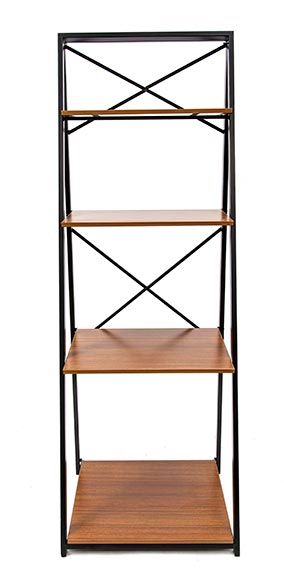 The basic table is just the right size for sewing, crafts or a small study desk. The metal/soft-side organizers work vertically and horizontally.
The basic table is just the right size for sewing, crafts or a small study desk. The metal/soft-side organizers work vertically and horizontally.
- Kitchen Origami products include a tall pantry rack, Baker’s rack, and a variety of kitchen carts.
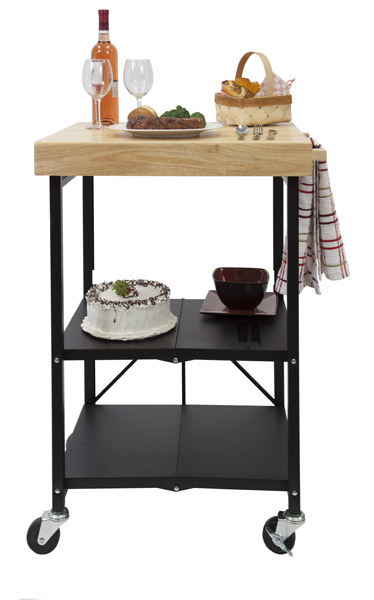
- Garage Origami racks come in multiple sizes, shapes and heights, and both with and without wheels, for everything from storeroom displays to corralling seasonal possessions.
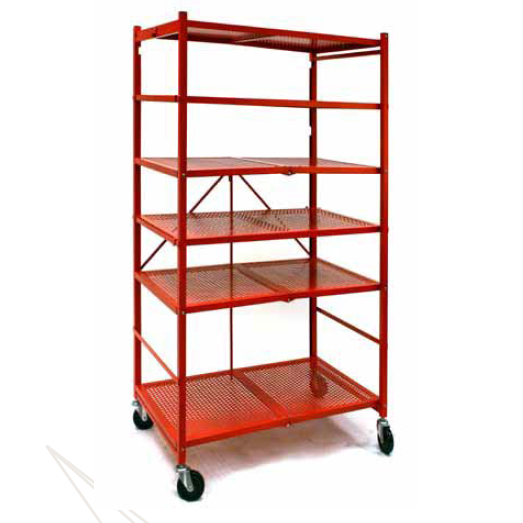 There are also small and full-size workbenches.
There are also small and full-size workbenches. - Garden Origami products include a 3-foot potting bench and a 4-tier greenhouse.
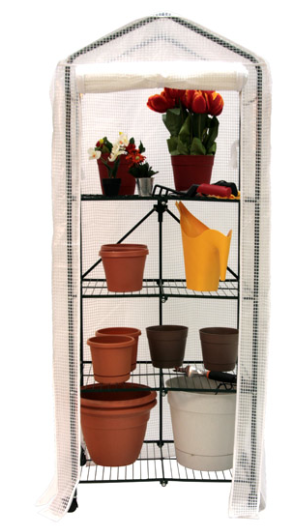
- Office Origami items include a six-tier bookshelf, a standard computer desk and a laptop trolley, as well as an intriguing folding trunk.
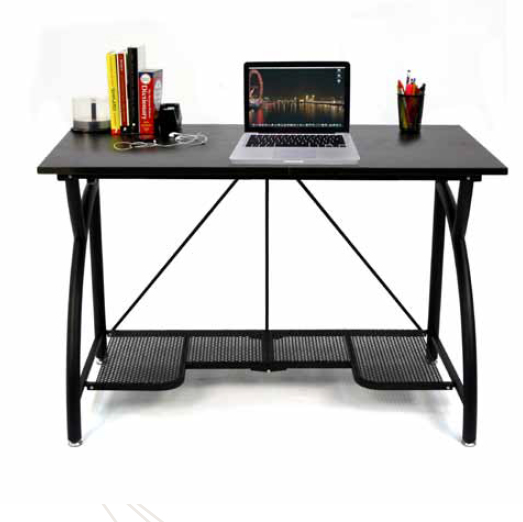
Other products, not shown on the Origami web site but included in the catalog distributed at the NAPO Expo, include an over-the-washer/dryer rack, additional general-purpose shelving units and bookshelves, a TV stand with extra tiers, and soft canvas rack and cart covers.
The Origami racks and other shelving items seemed impressively sturdy and easy to “unfold” into place; most of the shelves for the larger racks have a 250 pound weight-bearing capacity. (The pantry rack, computer desk and workbenches support 100 pounds; the laptop trolley, 50 pounds.)
Pricing for the various units ranges from $49.99 to $299.99, though the vast majority of items are under $150. Origami’s shelves, racks, tables and organizers are so new that there’s no distribution information readily available on the website, but if you’re willing to have something shipped, you may purchase through the Origami web site at each individual product page, or visit Amazon to purchase a small sub-set of Origami racks.
SOFI
SOFI™ is a new product from an old friend. You’re almost assuredly familiar with Bankers Boxes, made by Fellowes, either from personal use at home or work, or via This Is Not Your Grandfather’s Bankers Box. We’ve talked previously about the advances in Bankers Boxes in recent years, but this is something brand new — a mix-and-match storage organization system.
Each item this line is stain-guard protected, with a silk-textured exterior and a patterned (SOFI materials say “stylish,” but that’s subjective) interior. All of the items below, with the exception of the HEX boxes, have strong woven handles with brass rivets. All but the Hex Boxes boxes and STAX shelves are made of up to 80% recycled content.
The SOFI elements, from smallest to largest, are:
Hex Box™ — These hexagonal open-top containers measure 4″ H x 5″ W x 4.25″ D and are designed to organize small items in the open, on shelves, nightstands, or dressers, or for organizing the interior of easily cluttered drawers and cabinets. SOFI Hex Boxes come two to a package, and you can use the enclosed clips to create a sort of honeycombed organizing system by fastening two or more HEX Boxes together.
Zipper Tote™ — This cube-style tote comes in two sizes, Small (10″ H x 10.75″ W x 10.75″ D) and Tall (13″ H x 10.75″ W x 10.75″ D), and the vertical intersections of the front (handled) panel with the flanking panels zips down to provide easy access to contents.
Rax Bin™ — Angled sides of this open-top bin allow both easy access and a full view of the contents, making it suitable for wallets, purses, totes and other items you would stack vertically. It measures 10″ H x 15″ W x 13″ D.
Brix Bin™ — Envisioned for bulkier items like linens, toys and chunky accessories, this bin measures 10″ H x 15.5″ W x 10.75″ D.
Brix Box™ — Like the Zipper Tote, this cube-style tote comes in two sizes, Small (10″ H x 10.75″ W x 10.75″ D) and Tall (13″ H x 10.75″ W x 10.75″ D, as shown below), but lacks the zip-down panel.
The smaller Brix Box™ is compatible with the Stax Shelf, below.
Stax Shelf™ — Designed to help make the most of vertical space by allowing stacking, this mini-cupboard allows you to stack two of the small Brix Boxes vertically; multiple Stax Shelves could be put together horizontally or vertically (with the enclosed connecting clips) to create an organized system of stackable (small) Brix Boxes. You may also use the shelf on its own, without internal boxes. 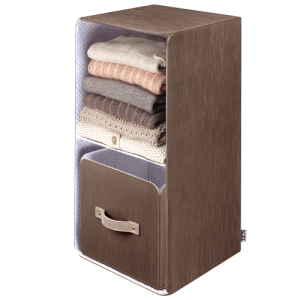 The central shelf has a 15 pound capacity; the unit measures 24″ H x 12″ W x 12″ D.
The central shelf has a 15 pound capacity; the unit measures 24″ H x 12″ W x 12″ D.
SOFI products seemed sturdy enough, from the cursory glance I got at the crowded NAPO Expo. However, if you have roughhousing tiny humans (or pets) intent on putting these storage items through their paces, you might want to add pieces slowly and review how your more wackadoodle household members deal with them.
The main drawback I see with SOFI, and this is certainly subjective, is that the line currently comes in a very drab, manly, retro brown, recalling the panelling in my parents’ 1970s living room, and the interior blue and white pattern doesn’t provoke much fashionista excitement, either. SOFI’s tag line is “So functional. So fashionable.” I’d agree to the former, but am unpersuaded as to the latter.
SOFI products are sold at Amazon, Staples, Office Depot, Wal-Mart and Target, and other retailers, with prices ranging from $10-$30.
Check out the video of SOFI in action.
Origami and SOFI were just two household organizing products to make their debut at this year’s NAPO Expo. Later in this recap series, we’ll revisit some old favorites to see what new tricks they had on display. Until then, make sure you haven’t missed some of the prior posts in this series:
NAPO 2015: Conference By the (Organizing) Books
NAPO 2015: PhD in Productivity at the College of Organizing Knowledge
NEET & Cozy Cables: A NAPO 2015 EXPO Organizers’ Choice Award Winner
Paper Doll’s Geeky Organizing Love: 6 Tips To Declutter With Your Darling
When your Valentine presents you with a gift box, whether packaged in classic Tiffany Blue or wrapped in lopsided, awkwardly taped, Sunday comics pages, your heart warms. When love fills your heart, and a gift fills your outstretched hands, it’s the thought that counts. But other times, the people you love present you with clutter, like a pet presenting you with a deceased mouse or squirrel, and just the thought of it can add a wintry layer of permafrost around the warmest of hearts.
As a professional organizer, I often work with clients whose efforts are not helped — or worse, are sabotaged — by their spouses or significant others. Here are a sampling of tips to help you help your sweetheart join in the organizing process in your home without tears or tantrums.
1) PURGE THE JUDGMENT AND TOSS THE GUILT
The first key to achieving organization as a joint effort is to remember that disorganization isn’t a character flaw. It’s not a measure of your sweetie’s maturity, intellect or worth. By and large, unless we’re discussing matters of legal concerns, financial issues, or personal safety (where a disorganized kitchen turns into a case for Tyvek-suited folks from the Centers for Disease Control), organizing is rarely a matter of right vs. wrong, but one of effective vs. ineffective.
It’s just a mismatch between the skills and systems already in place and the ever-changing demands of the world, including your demands (ahem, expectations) of your loved one.
Making people feel guilty about their clutter doesn’t help — and indeed, it can hurt their self-esteem and the loving bonds you share. Instead, create a guilt-free environment in which both getting organized and being organized can be seen as beneficial, fun and easy.
2) CATEGORIZE THE PURPOSE: START SPEAKING THE SAME LANGUAGE
With Valentine’s Day approaching, this is a romantic week, but organizing is not a particularly romantic conversational topic. Moving forward depends on making sure you start from the same place. Perhaps you’re aware of The Five Love Languages? You may know that your love language is “acts of service” and suspect your spouse’s love language is “words of affirmation.” Meanwhile, your honeybunny doesn’t have a clue about that and feels like Captain Picard relaying the Epic of Gilgamesh while trying to learn the metaphors of Tamarian before it’s too late.
You’re going to have to get on the same page and tell your loved one that for the two of you to face the beast at Tanagra (a common foe) you’re going to have to become Darmok and Jalad at Tanagra (and work together).
Start by making sure you both understand what it means to be organized, and why it’s important to get organized. For example, visual appeal just isn’t a huge motivator for many individuals. If someone is not already actively concerned with how things look, feeling pushed to declutter merely to make the house “pretty” is often a deal-breaker.
Instead of aesthetics, focus on the major tangible, temporal and experiential benefits of getting organized. Discuss how some new skills and systems will help the family save money (which can be better spent on nifty items and meaningful experiences). Show your sweetheart how the clutter of too many things in various locations (rather than in unified, categorized, even *labeled* storage) means it’s hard to find things, and how, when things are difficult to find, we tend to buy duplicates and triplicates. Reflect upon how disorganization often means missing deadlines (for filing taxes, returning rented items, paying bills, etc.), thereby causing you to have to pay fines and fees, or pay higher prices when coupons or discounts have expired.
Explore how a few organizing tweaks may also save time. If cluttered possessions make it hard to find everything from a clean shirt to the camera charger to the invitation to a wedding you’re attending, it’s slowing you down, giving you, your spouse and the family less time to focus on doing the things you actually enjoy.
If disorganization is causing you anxiety, explain that to your loved one, without blame. If you can clarify that cluttered paperwork and passwords for handling your finances makes you feel uneasy about the future, that shared clarity gives you a starting point for discussion.
Let your beloved know that you don’t see the time spent organizing as the goal, per se, but as a way to get to the goal of having more personal and family fun time.
Show your spouse the way organization (at home, at work, and for special events and activities) can reduce stress and increase overall productivity.
3) IDENTIFY THE CHALLENGES SO YOU CAN MAKE IT EASY
Next, brainstorm together how you can make the process easier. Ask your spouse what makes participating in the current system difficult in the first place.
Does your sweetie leave a phone charger, wallet, keys, pocket change and clothing in little piles all over the kitchen, living room and bedroom? Does your darling feel like there’s no place or space designated just for him or her? Perhaps the solution is as simple as figuring out what spaces would be convenient for each (a valet hook inside the closet, a bowl and charging block on a table in the entry nook, above a drawer designated just for them) and declaring them official!
Are they putting things down instead of putting things away because they don’t want to be “made wrong” by storing something where they think you’ll say it doesn’t belong? Do they cringe at the prospect of feeling clueless or being corrected?
Find ways to be equal partners, instead. Make decisions together, and then label the spaces so everyone feels empowered to put things away.
Ask your beloved if there are current storage areas that aren’t convenient – places where items are housed that don’t feel logical, or aren’t easily accessed – and rethink the placement. Perhaps the labels for the family filing system aren’t as intuitive as you think, leading to paperwork procrastination?
Everything should have a home, and if the storage place is conveniently located and labeled, it makes it easier to put things away.
Paint an outline of the tools that go on the pegboard in the garage to make it simpler to return them. Work together to label family financial, legal and medical files, or label the edges of shelves in the linen closet so everyone knows where twin sheet sets should go.
If you or your sweetie is artistic, sketch a fun little map of where foods belong in the fridge or pantry and post it on the door.
Is “when?” more of a problem than “where?” Does your spouse or significant other just not remember to do the tasks because of “clutter blindness?” If visual triggers don’t work, what about a cell phone alarm at certain times of the day, with ring tones of songs that are funny or keyed to the task at hand?
Is time an obstacle? Build time into the family schedule (perhaps a nightly 15 minutes before dinner, or mid-morning on Saturdays) for everyone (kids and grownups who act like kids, alike), to tackle their organizing tasks and brainstorm solutions to frequent annoyances.
4) MAKE IT FUN TO MAKE IT STICK
Research shows that we all have a limited amount of willpower, so instead of expecting one another to create and stick to new habits because they’re for the common good, create incentives for sticking to the new game plan.
In The Princess Bride, Westley acquiesced with a quiet “As you wish,” to Buttercup.
Once he was unmasked as the Dread Pirate Roberts and they were reunited, Buttercup (and we) learned that he wasn’t being passive-aggressive; it was his way of saying he loved her. However, if your beloved thinks of organizing as a chore, and thus procrastinates on promised clutter-busting tasks, leading to resentment on both sides, find ways to make behavioral changes an adventure, a challenge or a competition.
Appeal to the big kid inside and document successes with points or rewards. Encourage trying to beat a personal best. Consider a Seinfeldian “Don’t break the chain” effort at momentum. Just like companies have “152 days without an accident,” to avoid safety violations, you could have a kitschy whiteboard in the house keeping track of how many days your household has gone without the kids being late for school, or you having to bug one another to unload the dishwasher or put away the [laundry, gadgets, X-Box, etc.].
Once systems are in place, schedule organizing maintenance time daily and play funny music with silly lyrics to set the tone. If you have kids, you may have to listen to Let It Go for the millionth time, but if it’s just you and your sweetheart, fifteen minutes of 80s TV theme songs or some Weird Al Yankovic should do the trick.
If there are household and organizing tasks your sweetheart just can’t stand, why not make a trade? Nobody says you always have to unload the dishwasher and your partner must balance the checkbook. Exchange the least-desirable tasks and you might both gain motivation in new areas.
5) ACCEPT DIFFERING STANDARDS
Sometimes, the organizing issues between sweethearts has less to do with overcoming obstacles and identifying incentives, and more to do with what’s behind that lack of communication. To borrow from Star Trek again, some people come from a background of “Temba, his arms open,” (meaning “take or use this” — a gift) while others are more “Temba, at rest.” (where a gift has been refused or rebuffed).
In other words, some people prefer a lot of stuff around them, while others want a more streamlined or austere set-up. Your beloved’s dainty teacup collection is no less (and no more) worthy of consideration than your carefully curated 30-year-old Transformers action figures. But you have to agree on location, and keeping something on display comes with an obligation to care for it (and yes, people, that does mean dusting)!
If you came from a household where everything that wasn’t being used that minute was immediately put away, but your significant other came from one with more relaxed, cozy standards, it’s unreasonable to expect the other person to bend to your desires all the time.
For areas where compromise isn’t acceptable to the partner who wants things to be more than functionally organized but also fit a very specific aesthetic, recognize that this is not your honey’s “flaw” for you to correct. If you want to keep seven decorative pillows on the bed, while your spouse only cares about the ones on which you lay your heads, re-evaluate how important it is for the other person to join your Pinterest-Perfect perspective.
In other words, work together to find a “win” that’s valid for everyone concerned. If the reason for organizing is more tangible and meaningful than “The house looks so much nicer when it’s feng-shui-ed and organized,” then you never have to fear your darling’s resentment over couch cushions bubbling up into a loud, public reference to Doctor Who villains.
6) THINK OUTSIDE THE STORAGE BOX AND CONSIDER OUTSIDE RESOURCES
Have patience, and recognize that not everyone starts from the same place. It’s pointless to yell, “You should know how to do this!” and it’s unreasonable to expect that everyone has the same skills of pattern recognition or ability to conceptualize abstract solutions. Similarly, there are areas where there are no rights and wrongs, but merely where couples have differing organizing styles and retrieval preferences.
You wouldn’t set your own arm if it were broken, would you? You don’t expect people to be able to churn their own butter. Convey to your spouse the idea of organizing as a combination of skill and training. Can’t we all use a little help with some things? If you’re having trouble working things out together, discuss getting a trainer for *organizational* fitness!
Engaging the services of a professional organizer allows both you and your beloved to benefit from the technical expertise of a neutral, judgment-free third party. A professional organizer can provide advice and solutions that neither of you might have even considered, allowing you to move forward as loving, equal partners. (One might even say, as Valentines.)
Visit the National Association of Professional Organizers to find someone who can help you and your spouse find common ground for your organizing solutions. Neighbors to the north can check in with Professional Organizers in Canada.) The Board of Certification of Professional Organizers also has an online directory of its certificants (Paper Doll, included). And if you and/or your honey are dealing with more complex issues than situational disorganization, you may very well benefit from the guidance of the dedicated experts affiliated with the Institute for Challenging Disorganization.
Readers, unlike the TARDIS, your drawers and cabinets are not bigger on the inside. Only so much stuff can fit in so much space. But if you take this organizing advice to heart, there will always be enough space for you and the one you love.


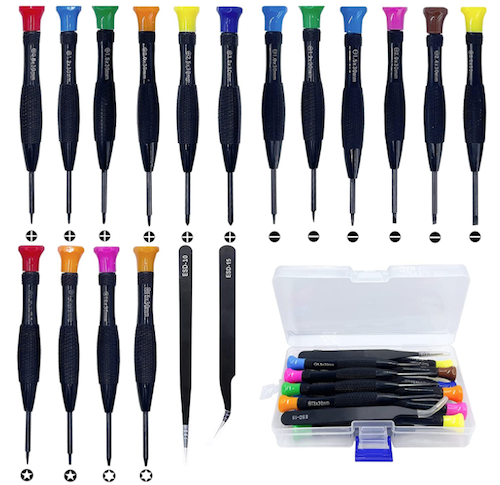

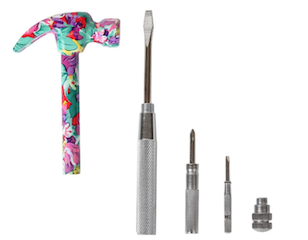





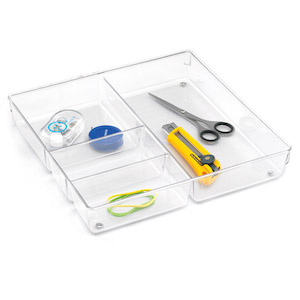 Mesh desk drawer organizers from office supply stores are usually inexpensive, low-key attractive, and work well when you want to buy just one thing. This
Mesh desk drawer organizers from office supply stores are usually inexpensive, low-key attractive, and work well when you want to buy just one thing. This 

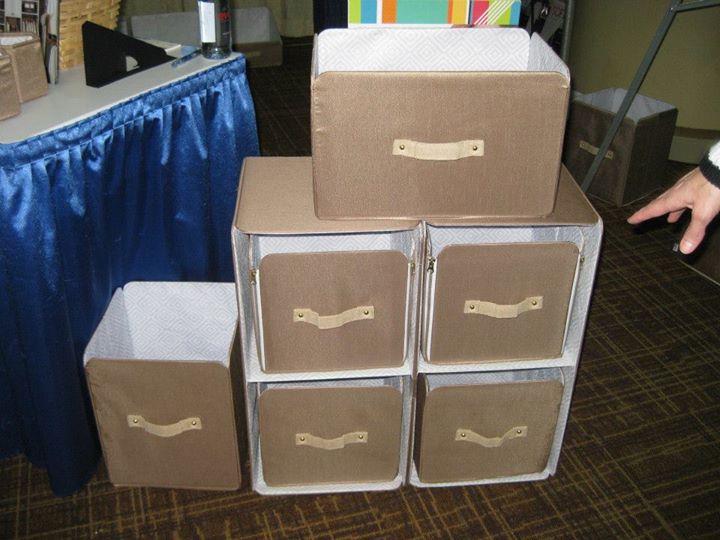
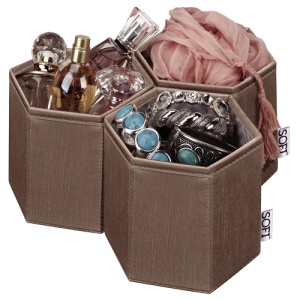
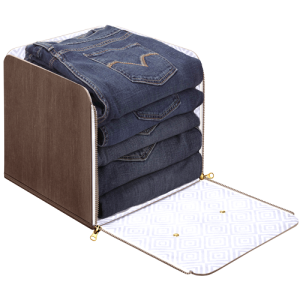
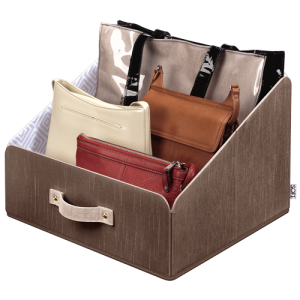
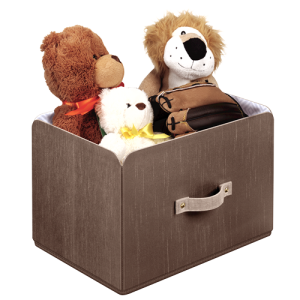
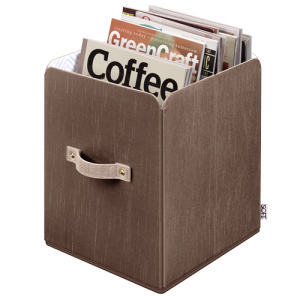







Follow Me